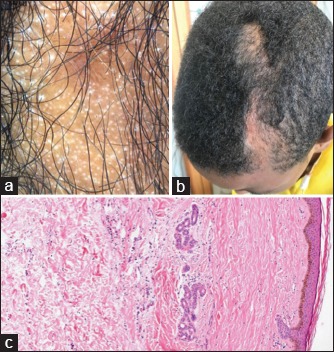Sir,
A 7-year-old boy presented with a progressive atrophic and slightly depressed linear plaque of alopecia on the paramedian scalp, forehead, and left eyebrow [Figure 1]. He had no relevant medical history. The trichoscopy showed pinpoint white dots with the loss of follicular openings, peripilar casts, pili torti, and areas with short regrowing hairs. In skin biopsy, epidermis showed atrophy and flattening of the rete of ridges with hyalinization and widening of dermal collagen bundles with the loss of their fibrillar architecture, and it was extended into the subcutis. These findings are compatible with morphea en coup de sabre. No neurological and ophthalmological alterations were found. Cerebral magnetic resonance imaging showed no intracranial lesions. Systemic immunosuppressive therapy was started due to progression of plaque despite topical treatment. Oral treatment with prednisolone and methotrexate was favorable.
Figure 1.

(a) Pinpoint white dots with loss of follicular openings, peripilar casts, pili torti, and areas with short regrowing hairs on trichoscopy. (b) Atrophic and depressed linear plaque of alopecia on scalp. (c) Atrophy and flattening of the rete of ridges with hyalinization and widening of dermal collagen bundles with loss of their fibrillar architecture on histology
Morphea en coup de sabre is a form of localized scleroderma that characteristically affects the face and frontoparietal region of the scalp. The lesions on the scalp produce linear plaques of alopecia that are frequently atrophic with alteration of pigmentation and depression resulting in bone deformity.[1] It is commonly associated with neurological and ophthalmological complications.[2,3] Morphea can result in a secondary scarring alopecia. Histopathologic findings can vary depending on the stage of disease, normally includes collagen deposition in the dermis and subcutis, vascular and adnexal structure changes, inflammatory infiltrate, and atrophic follicular structures.[4] In the diagnostic workup of alopecia, a relevant role has been attributed to trichoscopy over the past years. There are few reports about dermoscopic features of morphea,[5] but there are no reports in the literature about trichoscopy characteristic in alopecia due to morphea en coup de sabre. In our knowledge, this is the first and detailed report of trichoscopy in linear morphea disease.
Financial support and sponsorship
Nil.
Conflicts of interest
There are no conflicts of interest.
REFERENCES
- 1.Bielsa Marsol I. Update on the classification and treatment of localized scleroderma. Actas Dermosifiliogr. 2013;104:654–66. doi: 10.1016/j.adengl.2012.10.012. [DOI] [PubMed] [Google Scholar]
- 2.Pinho J, Rocha J, Sousa F, Macedo C, Soares-Fernandes J, Cerqueira J, et al. Localized scleroderma en coup de sabre in the Neurology Clinic. Mult Scler Relat Disord. 2016;8:96–8. doi: 10.1016/j.msard.2016.05.013. [DOI] [PubMed] [Google Scholar]
- 3.Zannin ME, Martini G, Athreya BH, Russo R, Higgins G, Vittadello F, et al. Ocular involvement in children with localised scleroderma: A multi-centre study. Br J Ophthalmol. 2007;91:1311–4. doi: 10.1136/bjo.2007.116038. [DOI] [PMC free article] [PubMed] [Google Scholar]
- 4.Pierre-Louis M, Sperling LC, Wilke MS, Hordinsky MK. Distinctive histopathologic findings in linear morphea (en coup de sabre) alopecia. J Cutan Pathol. 2013;40:580–4. doi: 10.1111/cup.12124. [DOI] [PubMed] [Google Scholar]
- 5.Shim WH, Jwa SW, Song M, Kim HS, Ko HC, Kim MB, et al. Diagnostic usefulness of dermatoscopy in differentiating lichen sclerous et atrophicus from morphea. J Am Acad Dermatol. 2012;66:690–1. doi: 10.1016/j.jaad.2011.06.042. [DOI] [PubMed] [Google Scholar]


